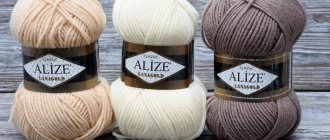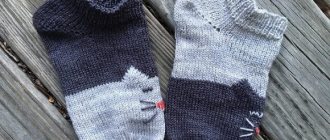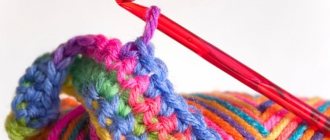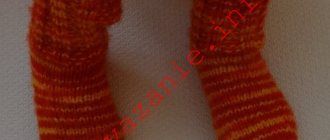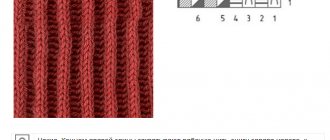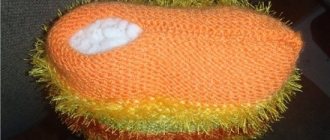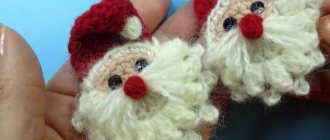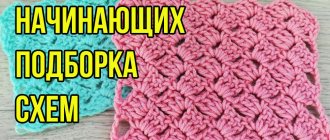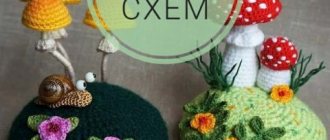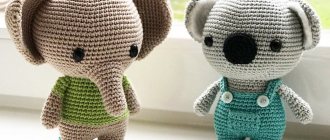What can be knitted from the remains of different yarns - of course, indoor slippers with knitting needles. For the cold season, wool blend or wool yarn with several threads is suitable. Well, in the summer, of course, cotton threads, cord, and linen are better. Before knitting slippers, think about what is best to make the sole: you can buy a ready-made insole, or cut it from felt, fur, leather.
How to knit simple women's slippers with knitting needles
Even a beginner in needlework can handle knitting slippers in a simple way. It’s better to start your journey in knitting slippers without a seam using 5 knitting needles.
Cast on 3 stitches and knit the first row.
Row 2: k10, p1, k10, p1, k10.
3rd row: knit according to the pattern
Row 4: k10, p1, k10, p1, k10.
Knit the product in this way until the 16th row. Now let's start knitting the heel according to the report: knit 10, purl 2. - center of the heel. At the end of the row, tie one loop on the side. We turn the product.
Row 17: slip 1, knit 10, slip 1 (center of heel), side knit stitch. Throw the removed loop over the knitted one. Repeat again and add 2 side heel pieces.
In even rows, purl the side and center loops together.
In the front rows we remove the outermost loop, the next front one and the removed one we throw over the knitted one.
To knit the central part you need 12 loops, add another 10 loops, casting along the edge.
Rotate the product. We knit the side and central loops, and on the opposite side add 10 loops to the edge.
In total, you will get 32 loops on three knitting needles. We knit one row with facial loops.
On the purl row we have a report: k10, p1, k10, p1, k10.
We continue to knit the slippers to the required height. At the end of the front row, add 8 loops and close the knitting in a circle.
Distribute the stitches onto 4 needles and then knit in garter stitch in the round.
We knit the slipper sock in stockinette stitch, starting with the first knitting needle and knitting 1 knit. loop, slip 1, knit 1. Throw the removed one over the knitted one, knit the remaining loops. We knit the loops on the second knitting needle, knit 1 together at the end of the loop.
We knit the loops on the third knitting needle as on the first knitting needle, and on the fourth knitting needle as on the second.
In odd rows we decrease evenly to complete the knitting. And then we will decrease in each row.
Then we close the remaining loops by folding the knitting needles two at a time together in parallel.
You can decorate your slippers with pompoms or other decorative elements.
Additional tools
From additional tools, you can take another set of knitting needles, preferably on a fishing line, onto which, if necessary, all the loops of the heel or other element to be knitted will be lowered.
Experienced craftswomen can lower their knitting needles onto a thread of a contrasting color. But for beginners it is still more convenient to use a knitting needle.
Seamless slippers with knitting needles: how to knit without a seam with a description
Beautiful slippers can be knitted on just two needles and you don’t even need to sew them later, as they are knitted straight from the toes to the heel using circular knitting needles. You can choose the knitting pattern at your discretion.
Cast on 26 stitches to start knitting beautiful slippers without a seam. We knit the heel 12 rows high, alternating between knits and purls. The number of rows should be equal to the height of the heel. It may be different.
Next, we knit the sole of the slippers: knit a row with the front loops, only tie the 18th and 19th loops together behind the back wall. We knit the purl row until there are 7 loops left on the second knitting needle and tie the two in front of them together. This way the loops will decrease until they run out.
We knit the sides of the slipper. Cast on 7 loops on each side, and hook the last loop to the top one - this way the transition will not be visible.
Using the tail that was left over when casting on, knit 8 knits. and continue knitting with the main thread. Place 7 loops on the knitting needle from the other side and knit the front row.
Knit a purl row, and then alternate knit and purl stitches to the required depth - the middle of the thumb using white thread. You will get 24 loops on the knitting needle.
Making loop decreases:
Front row: 5 loops, 3 in., 6 loops, 3 in., 6 loops
Purl row (no decreases).
Front row: 4 loops, 3 in., 4 loops, 3 in., 5 loops.
Purl row.
Front row: 4 loops, 3 in., 2 loops, 3 in., 4 loops
Purl row
Front row: 2 loops, 2 in., 2 loops, 2 in., 3 loops
There are 9 loops left on the knitting needle.
How to knit a sock: purl stitches to the end of the row, at the last stitch, hook a loop from the side braid and purl a stitch. You will get 10 loops. Turn the fabric and in the next purl row, hook one side loop at a time. You will get a knitted slipper on two knitting needles without a seam.
Front row: 3 loops, 3 in., 3 loops, add 1 loop from the side braid. Knit further to the required length of the sock.
We close the row like this: knit 2 knits and put the loop on the knitting needle. Hook the last loop onto the side loop using a hook and pull it inside the sock.
Selection of yarn and knitting needles
When choosing yarn for knitting slippers, you must take into account the material requirements for such products. These threads should not only be beautiful, but also warm, resistant to abrasion and wear, strong, and soft. The load on slippers is very high, but it is necessary that their use be comfortable.
If the product is intended for a child, it is better to give preference to hypoallergenic yarn. Threads with the addition of acrylic are also suitable for knitting slippers, which significantly increases their wear resistance. Wool yarn is also in demand, it will wear out a little faster, but the material is natural and healthy.
Manufacturers offer special yarn for house shoes, usually it is marked “sock”.
It will not be possible to accurately calculate the required number of skeins of thread. Consumption depends on many factors:
- density and type of knitting;
- thickness and length of thread in a skein, etc.
For an approximate calculation, you can use online calculators or estimate the number of skeins of thread using the following method:
- take similar yarn (or purchase a skein of the one from which you plan to knit);
- from this thread knit a square 10 x 10 cm;
- wash and dry the sample to see how the product behaves during operation;
- count the number of loops and rows in the workpiece, write them down;
- dissolve the square, calculate the footage and also write it down;
- calculate the area of the product, that is, how many such squares will be needed to make slippers;
- multiply the number of squares obtained by the required amount of yarn (which will be used for one element);
- Convert these values into skeins, focusing on the length of the thread.
It is better to add 10-20% to the resulting amount, since the measurement is approximate.
The size of the knitting needles should be selected based on the yarn number - the necessary information is usually written on the label. The thinner the thread, the thinner the tool required. Most often, knitting needles No. 2.5–3 are used.
"Sock"
Acrylic
Wool Knitting Needles
How to knit slippers from a rectangle with knitting needles: detailed description
Finding a simpler version of knitted slippers is almost impossible. After all, they are obtained from a simple rectangle, the size of which must be calculated depending on the size of the foot. One edge of the rectangle can be crocheted.
In this version, the rectangle has a size of 10*35 cm, knitted in garter stitch from YarnArt yarn 35% wool, 65% acrylic, 260m/100g). But you must take into account the composition and thickness of the yarn.
For slippers size 36-38, cast on 50 stitches. We knit 90 rows in garter stitch and bind off the loops. Crochet the top row with double crochet stitches every 3 stitches.
Bend the finished rectangle at the corner at the toe and sew the sole. Sew the sole of the rest of the slipper and sew the two parts of the slipper on top under the posts.
To knit slippers using rectangle needles, you will need some yarn, so you can knit them from leftovers.
Rectangular slippers
This product is very simple to make. It is enough to knit a rectangle of the required size. Two corners are sewn on one side, forming a heel seam.
On the other hand, 2 corners overlap each other and are secured with a button or bead.
The edge can be additionally crocheted to make it look attractive.
Knitting openwork slippers on two knitting needles: master class
Beautiful openwork slippers can not only warm your feet at home, but also lift your spirits.
Any medium weight yarn is suitable for knitting openwork slippers. Select the knitting needles according to the yarn.
Size 23/25/25.5
Cast on 13 stitches
1st row: knit 3, yarn over, pull through, yarn over, double pull through, yarn over, 2 stitches in one, yarn over, knit 3.
All even rows are knitted with purl stitches.
3rd row: k4, double broach, yarn over, 2 loops in one, yarn over, k4.
Row 5: k4, knit 2, knit 2, knit 5.
Row 7: K3, 2 loops in one, 2 loops in one, k1, yarn over, pull through, k3.
Row 9: K2, 2 loops in one, 2 loops in one, k1, yarn over, 2 broaches, k2.
Row 11: knit, 2 loops in one, 2 loops in one, knit 3, yarn over, 2 broaches, knit.
Row 13: 2 loops in one, 2 loops in one, knit 5, 2 broaches
Row 15: knit, yo, broach, yo, broach, k3, 2 loops in one, yo, 2 loops in one, yo, knit.
Row 17: K2, yarn over, pull through, yarn over, pull through, knit, 2 loops in one, yarn over, 2 loops in one, yarn over, k2.
Row 19: same as 1st
21st row: like 3rd
23rd row: like 5th
Row 24: purl
How to knit a sole
We start knitting from the thumb. Cast on 17 stitches and knit 2 rows using stockinette stitch. 3rd row: from the first and last loop we knit 2 loops, k1. fourth row with purl stitches.
Repeat the increments 5 times. You will get 29 loops.
Continue knitting until the length is 16.5/18/20.5 cm.
In the next row, knit *1 knit, 2 stitches in one knit.*, repeat ** until the last 3 loops, 1 pull, 1 knit. Knit 3 rows without additions. Repeat the last 4 rows 3 times.
You will get 21 loops. Next in the row: *k1, 2 stitches in k1.* repeat until last 3 stitches, pull 1, k1. we knit the purl row, and the next one like this: *knit 1, 2 loops in knit 1.* repeat until the last 3 loops, stretch 1, knit 1. Next is the following row: *P1, 2 stitches in P1. behind the back wall*, repeat until the last 3 loops, 2 loops in 1 purl., 1 purl. repeat last row 2 times.
Cast off the remaining 11 stitches to create a heel.
We knit the upper part:
Starts with the thumb. Cast on 17 stitches and knit 2 rows. In the 3rd row, knit 2 loops from the first and last loops, finish the row with 1 person. Then the purl row is knitted.
The openwork pattern is knitted like this: knit 2 from 1 stitch, place a marker.
Knit 1 row with an openwork pattern (as described above) of 13 loops, put a marker, knit 1, from 1 loop - 2 loops.
The next row is knitted with purl stitches. Repeat the last two rows 4 times and finish with 10 rows of lace pattern. There are 29 loops in total.
Next we knit like this:
1st row: 3 knits, 2 loops in 1 knit, yarn over, 3 knits, 11th row of openwork pattern, 3 knits, 2 loops in 1 knit, yo, 3 knits.
All even rows are knitted purl
3rd row: 2 knits, 2 loops in 1 knit, yo, 2 loops in 1 knit, yo, 2 knits, 13th row of openwork pattern, 2 knits, 2 loops in 1 knit, yo, 2 loops in 1 knits., yarn over, knit 2.
5 row: 3 knits, 2 loops in 1 knit, yarn over, 3 knits, 15th row of openwork pattern, 3 knits, 2 loops in 1 knit, yo, 3 knits.
We knit 5 rows without decreasing, knitting 16-20 rows of an openwork pattern
11 row: 3 knits, 2 loops in 1 knit, yarn over, 3 knits, 21 rows of openwork pattern, 3 knits, 2 loops in 1 knit, yo, 3 knits.
13 row: 2 knits, 2 loops in 1 knit, yo, 2 loops in 1 knit, yo, 2 knits, 23rd row of openwork pattern, 2 knits, 2 loops in 1 knit, yo, 2 loops in 1 knits., yarn over, 2 knits.
Row 15: K3, 2 stitches in k1, yarn over, bind off 5 stitches, k7. (including loops from the knitting needle after casting), 2 loops in 1 knit, yarn over, k3, on the last 12 loops make decreases along the edge in 3 rows, 9 loops in total.
Rows 17-18: no decreases
Row 19: K4, 2 stitches in k1, yarn over, k3.
Row 21: K3, 2 stitches in k1, 2 loops in k1, k2.
23rd row: like 19th
Rows 25, 27: knit stitches
Repeat the last 10 rows until the height is 14.5/16/18 cm.
The last row is purl and you can bind off the loops.
To make openwork slippers look beautiful, tie the top edge. To do this, cast on 81/91/101 loops and knit 2 rows, closing the loops.
Assembling openwork slippers
Sew the back seam. We sew the double sole, folding the parts with the wrong sides. Sew the top to the double sole.
Preparing for work
This is interesting: Knitted sweaters for women: crocheted, knitted, for summer + DIAGRAMS with description and 140 PHOTOS
Knitting begins with knitting needles, and they come in different shapes, functions, and materials. The choice of knitting needles is directly related to what kind of design you want to create, as well as what kind of yarn you will use.
If according to your idea the elements should be small, use thin knitting needles. When knitting with thick needles, the stitches will come out larger. More information about choosing knitting needles is described in the video below.
VIDEO: Selecting knitting needles
Selecting knitting needles
How to choose the right knitting needles for yarn. The thickness of the knitting needles corresponds to the thickness of the thread.
The choice of yarn must also be approached with all responsibility, because the quality of the future product depends on it. To ensure that the product will serve you for a long time, choose wear-resistant yarn.
Woolen items will keep your feet warm in the winter, but will not keep you hot in the summer.
You should not pursue naturalness when choosing threads from pure wool. Such slippers will prick and slide, which is not at all suitable for children's products, for example.
Be sure to read the labels on yarn packages . They will tell you everything you need to know about threads: their composition, density, care instructions . Sometimes the label will also tell you which knitting needles the yarn is intended for.
You will also need:
- Tape measure;
- Thick needle with a large eye (gypsy needle);
- Markers for marking complex patterns;
- Pins;
- Hook;
- Leather or felt for the sole.
Make sure all your materials are of good quality.
Knitted slippers with felt soles
There is one drawback to homemade knitted slippers - the soles wear out quickly. Therefore, it would be more practical to decorate knitted house slippers with felt soles.
You can knit slippers in any way.
Measure the length of the insole and add a couple of cm of margin.
We measure the height of the heel.
Knit a long strip with knitting needles and attach it to the sole. Stepping back 0.5 cm from the edge, sew the strip to the sole.
It is necessary to lay out an overlapping strip at the front.
Knitted slippers with felt soles are knitted very quickly and will last for a long period.
Caring for knitted items
In order for knitted products, into which so much work has been invested by the craftswoman, to last as long as possible, it is important to properly care for them:
- It is better to wash things made from yarn by hand, the water should not be higher than 30 degrees;
- Do not allow excessive mechanical impact (squeezing, stretching, twisting);
- wash with special products suitable for the specific material;
- Rinse in water at the same temperature as when washing.
It is recommended to wash woolen items only with special detergents. Such products should not be twisted, stretched, deformed, or allowed to undergo strong changes in water temperature. You should wring out wool items like this: wrap them in cloth and leave them for a while. Drying should be done without additional heating, in the unfolded state.
It is better not to wash wool often; it is enough to air the slippers in the fresh air.
Cotton yarn can be machine washed at temperatures up to 40 degrees. It is better to dry it unfolded in the fresh air. Acrylic yarn can be machine washed on a delicate cycle with a special detergent. The item must first be placed in a special bag. Spinning is allowed at low speeds. Acrylic slippers must be dried on a horizontal surface, without additional heating. By following these simple recommendations, you can preserve the presentability of knitted items for a long time, while significantly extending their service life.
Wash by hand in water whose temperature is not higher than 30 degrees Avoid excessive mechanical impact Wash with special products suitable for the specific material
Single knitted slippers for women
Knitting women's slippers with knitting needles in one piece is as easy as shelling pears; there is no need to sew the sole and upper part together afterwards. The way it works is that you knit one piece and then simply sew it together with two seams.
Materials:
- Yarn: Nako (wool blend, 100g/210m)
- Knitting needles No. 3.25
Cast on 45 stitches
1st row: chrome, knit 6, * purl 1, knit 1 * – 15 times, purl 1, knit 6, chrome
2nd row: chrome, knit 6, *k1, purl 1* - 15 times, k1, k6, chrome
Rows 3-50: repeat rows 1-2 up to 16 cm in length.
We continue to knit with an elastic band
Row 51: chrome, *purl 1, knit 1*, repeat, purl 1, chrome.
Row 52: *K1, P1*, repeat, K1, chrome.
Rows 53-70: Repeat rows 51-52 until you have knitted the required length of the foot.
We make reductions:
Row 71: chrome, *knit 2 right*, repeat until last 2 stitches, knit 1, chrome. only 24 loops
Row 72: edge, *2 in.*, repeat. Chrome. There are 13 loops in total. Close the loops.
Sew the heel and top of the foot.
How to knit women's slippers with knitting needles
Women's indoor slippers can be associated with comfort and warmth, but in cold weather it is simply difficult to replace them with anything. You should take care of the onset of the cold season in advance and knit a pair of cute and warm, but cozy house slippers.
These slippers can be knitted from leftover yarn of different colors.
Materials
- Yarn NakoBambinoMarvel 50g/130m
- Knitting needles No. 3.5
Cast on 26 stitches
Knit 4 rows with knit stitches and change the yarn color.
Row 5: knit 10, yo, knit 4, yo, knit 10, yo
Next, knit all even rows with knit stitches, not forgetting the edge rows.
Change the color of the yarn every 4 rows.
7th row: chrome, knit 11, yarn over, knit 4, yo, knit 11, chrome
Row 9: chrome, knit 12, yo, knit 4, yo, knit 12, yo
11th row: chrome, knit 13, yarn over, knit 4, enakid, knit 13, chrome
We knit this way until there are 54 loops.
Knit 4 rows with knit stitches.
How to knit a sole:
1st row: edge, knit 31, purl 2, turn the product
2nd row: edge, knit 8, knit 2, turn the product
3rd row: edge, knit 8, purl 2, turn the product
4th row: edge, knit 8, knit 2, turn the product
Knit until 10 stitches remain. Pick up 18 stitches on each side and continue decreasing. Close all loops.
Knitting techniques
This is interesting: Knitted hats: diagram and description of hats for women and girls + 90 PHOTOS
There are various knitting techniques. They vary in difficulty levels; some can only be handled by masters. The choice of technique depends on how you want to see the result.
A common knitting method for beginners
This technique is specially designed for people who are not previously familiar with knitting.
The procedure is as follows:
- The first level should consist entirely of facial loops, i.e. such loops, when working on which the thread is located behind the working cloth;
- Starting from the second level, introduce a thread of a different color, knit it 2-4 levels;
- Changing colors every few levels, knit approximately 10-15 cm of fabric (depending on your size);
- After this, close about 8 elements on both sides, then knit the remaining section with a length corresponding to the length of the foot;
- At the next level, remove a stitch from each side;
- At the next level, subtractions are not needed, and at the last level, remove several elements again;
- Tighten the resulting elements with a stretched thread;
- The seam should run along the foot to the heel.
Do not try to knit slippers with a margin in case of incorrect measurements. This will make them too wide and will also slip off your feet due to their short height.
The resulting simple slippers can be decorated, for example, with laces and tassels. This method is good for its versatility - it allows you to knit slippers of all sizes, for men and women.
A clear video tutorial on this topic:
VIDEO: Knitting for beginners
Knitting
Knitting for beginners. 1 lesson
Knitting baby booties
The process of knitting baby booties is not particularly difficult even for beginners. In this matter, you can prove yourself as a fashion designer, creating a unique design that suits your child.
Choose yarn in bright colors - pink, blue, yellow - these colors attract and delight children.
If you are not yet ready for complex work and flights of fancy, follow this pattern to knit simple but comfortable baby booties:
- Using only knit stitches, knit the sole of the bootie (step 1);
- Along the length and width of the product, cast on 17 and 9 stitches, respectively (step 2);
- Next, continue knitting in the round, alternating rows with knit and purl stitches, and you need to start with the front row and finish with the purl. Knit one side only with knit stitches to form a toe (step 3);
- Tie the sides of the fabric together. Unfold the work and start knitting from the wrong side with knit stitches, also knitting the side stitches together (step 4);
- Knit the upper part of the bootie with an elastic pattern (step 5);
- Enjoy the finished product.
Sequence of actions when knitting booties for a child.
If everything is done correctly, you will end up with cute booties that will keep your baby warm and comfortable. The finished product can be decorated as desired.
If you want to decorate your booties with buttons or beads, sew them very tightly. Otherwise, the child may tear them off, and sometimes even accidentally swallow them.
VIDEO: Knitted booties - for children
Knitted booties - for children
Knitting baby booties + step by step. Knitted booties master class
Funny children's footprints
More confident craftsmen can try to create unique children's slippers, for example, footprints in the shape of various animals, such as a pig. Instructions for knitting such tracks are presented below.
At the first stage, work is done on the sole. Cast on approximately 24 stitches and work 12 rows . Then 7 times , one on each side. From the 14th row , start removing 2 elements , also 7 times . Increase and decrease 4 times in every second row and 3 times every other row.
Row 25 is the base of the upper part of the work. Cast on 8 more stitches to sew the heel. Then knit, adding a stitch on each side. In row 40, cast off 20 stitches and knit the rest, alternating stitches. Repeat the operation in row 45 . There will be approximately 58 rows in total.
The penultimate stage is assembly. The resulting ones must be sewn tightly, starting from the toe and then moving to the heel.
Finally, the final stage is decoration . Since the slippers are made in the shape of a pig, they need to be decorated with ears (knitted triangles), button eyes and heels.
Your child will have incredible fun walking in these shoes!
Knitted slippers for a child
Slippers with a pattern
Patterned slippers are the next level of knitting skill. Among the most common patterns, the most common one is the “braid” pattern. It's actually not difficult to create one. Below is a knitting pattern, where A1 is the pattern for the left shoe, and A2 is for the right. The pattern is designed for knitting boots in sizes 35/37 (a), 38/39 (b) and 40/41 (c).
The diagram shows the order of knitting the “Pigtail” pattern
So, let's start with the sole first. On the knitting needles you need to cast on 36/38/40 elements - for a/b/c sizes indicated above, respectively. Knit a section of fabric using garter stitch, i.e. exclusively with facial loops. You need to knit only on the first 11/13/13 loops, the rest are removed on the second knitting needle and set aside for a while. The first part of the elements is knitted according to the following principle:
- The first line is all knit stitches;
- Second line – 2 more knit stitches are added;
- Third line - 2 more knit stitches are added, by this point there should be 15/17/17;
- The fourth line - there is an alternation of one edge stitch and one stitch according to the pattern.
When the job is finished, you need to return to the second part of the stitches. The next step is to raise the loops of the sides of the top of the slipper by 12/14/16 elements. Then use one pin to mark the position of the toes, and the other to mark the middle of the heel. Knit 2 cm with knit stitches, and start decreasing one element on both sides of each pin, i.e. Each row is reduced by 4 stitches . You need to decrease it until the height reaches 5/5/6 cm. Then the loops are closed. This is what the final result looks like:
This is what the “Pigtail” pattern looks like on the finished work
The heel and toe can be stitched with synthetic thread for greater durability.
Creating trails with a pigtail pattern is more visual:
VIDEO: Knitting the Braids pattern
Knitting the Braids pattern
Braids are knitted using inclined loops: groups of loops are swapped using a third additional knitting needle and then knitted. The results are beautiful weaves. Braids are used for knitting warm sweaters and cardigans.
Footprints for men
In fact, these house shoes differ from others only, perhaps, in size, so don’t be afraid to take them on. Warm handmade footwear will be an excellent gift for February 23 or a birthday for a husband, friend, or even a work colleague, and it won’t take much time to knit them.
The procedure is as follows:
- Cast on about 60 stitches on a knitting needle;
- Knit 15 levels with an elastic pattern using knit stitches;
- Stretch the stitches onto two needles, and leave one of them in the center;
- Knit one half with facial loops, make a yarn over, knit the central part of the fabric;
- Yarn over again and work through the next part;
- Visually divide the working fabric into three parts, selecting 15 loops in the center;
- Initially, half of the loops are knitted, then the middle ones, leaving only the last one. It must be connected to the first loop of the second half.
- Turn the product and therefore knit this level according to the same principle.
- Continue in the same manner until there are only 15 stitches left in the center.
Men's footprints are no less cute than women's ones
If you stitch the foot with a larger knit, then such footprints will acquire another unexpected function - they will become a massager for the feet.
Detailed video about knitting woolen shoes for men:
VIDEO: Socks, footwear for men and women
Socks, footwear for men and women
The footprints will fit foot size 38-39 (24-25 cm). You will need 300 g of yarn: yarn 49% wool, 51% acrylic, 240 m in 100 g. We knit with thread in two folds. Hook 5-6 mm.
Footprints in Japanese style
Japanese-style tracks look much more sophisticated and complex than regular ones, but working on them is not particularly difficult.
The knitting plan is as follows:
- Knit 18 cm of fabric with the “Rib” pattern, alternating several knit stitches with several purl stitches;
- Start decreasing a few elements on the sides, continuing to knit only with knit stitches;
- Stop when the last 5 stitches remain on the needle;
- Make twenty rows of binding.
- Repeat the same steps on the other side.
As a result of these simple steps, you will get a pair of original tracks. For greater effect, the tracks can be decorated with buttons, embroidery or appliqué.
For embroidery and appliques, be sure to choose threads that do not fade, so that they do not ruin your slippers when washed. Pre-wash the threads in the washing machine. If after washing they do not leave marks on white fabric, you can safely use them for work.
How to knit charming Japanese footwear:
VIDEO: Japanese slippers
Japanese slippers
How to knit JAPANESE slippers? Knitting. 43,479 views
Ready-made pair, made in Japanese style
House boots
An even more insulated version of house shoes are knitted boots. They keep the foot and shin warm, making them even more comfortable. Of course, the production price of such house boots is higher than that of other models, since much more material is consumed.
The scheme of work is as follows:
- You need to start from the sole. Calculate its length, and then knit the fabric by casting 10 stitches on the knitting needle;
- Cast on loops on all sides;
- Work 5 lines in a circle using only knit stitches;
- Then 3 rows alternate between purl and knit stitches (3 pieces each);
- Knit 3 purl stitches and slip them onto the same needle to form a turn;
- Next, you need to alternate 6 purl and 3 knit elements, avoiding the element that is located near the last knitting needle;
- When the previous step is completed, move the left stitch to the front needle and knit it together with the adjacent one;
- Continue working until there is only one loop left, knit it from the side;
- Unfold the row and knit 6 more rows;
- Continue knitting in the round (24 rows in total) until the product is ready.
To calculate the required number of loops, knit a small square before starting work. By measuring its sides and counting the loops, you can understand how many stitches per 1 cm you get. Then use your measurements in your work.
Incredibly warm boots will prevent your feet from getting cold in winter
Slippers made of squares
It turns out that not all tracks need to be knitted with a single fabric. For example, when knitting shoes from squares, each square is worked separately. As a result, the design turns out to be more interesting and personalized. Let's take a closer look at this technique.
The squares are knitted separately from each other, and different designs are usually chosen for them, independent of each other. “Honeycomb” pattern as the first ornament “Shells” pattern as the second .
Knitting pattern for the “Honeycomb” pattern
Pattern for the “Shell” pattern
Legend for the above diagrams:
Knit stitch on knit row or purl stitch on purl row.
Purl stitch in knit row or knit stitch in purl row.
Knitting two front elements.
Yarn over
The unknitted loop is removed onto the right knitting needle. The working thread is located behind the knitting needle.
The unknitted loop is removed onto the right knitting needle. The working thread is in front of the knitting needle.
Empty place.
When the individual squares are completed, all that remains is to sew them together into a single product. To do this, you need to act according to the following scheme presented below. The sides of square C are sewn to the sides of square D , the remaining edges are then tied.
Scheme for sewing squares
The finished product will look like this example:
The end result of slippers made from squares
If the instructions did not seem detailed enough to you:
VIDEO: Knitting. Simple slippers made from squares
Knitting. Simple slippers made of squares
Slippers made from squares, knitting. Knitting needles 3.5 mm, yarn 100 grams - 240 m.
Openwork footprints
Such slippers are knitted more for beauty than for warmth. They require painstaking work from the master, but the diagrams help to understand this matter.
The number of loops has already been calculated for sizes 35/37, 38/40 and 41/43, all you have to do is pull yourself together and get to work!
- You need to start, as usual, with a set of loops on a knitting needle, 57/57/61 loops for sizes a/b/c, respectively.
- For circular knitting, work the first row with knit stitches, the next row with purl stitches, then follow the directions in the pattern below.
Pattern for knitting an openwork trail
- Having knitted all the rows provided for in the pattern, you need to divide the loops into 2 parts: leave 25 stitches in the center to form the foot, the rest will go to create the heel;
- It's time to move on to working on the heel. Its height should ultimately be 5/5.5/6 cm. It is useful to mark the center of the canvas with a marker;
- Then you make decreases according to this principle:
- First row - stockinette stitch to the outermost 9/9/10 stitches, remove 1, add 1 knit stitch, thread a new stitch through the old one. Turn the canvas over;
- Second row - repeat the steps of the previous row, only the added loop should be purl;
- Third row - stockinette stitch up to the outermost 8/8/9 stitches, then completely according to the plan of the first row;
- Fourth row - stockinette stitch up to the outermost 8/8/9 stitches, then completely according to the plan of the second row;
Repeat such rows until 16/16/18 elements remain;
- Almost finished heels need to be raised by 12/14/15 stitches;
- Switch to circular knitting. There will be facial loops under the foot, in the central part follow pattern No. 2;
- Make decreases in every second row, there should be 8 of them in total;
- When knitting a toe, start decreasing 2 loops on each side. Decrease 4 stitches per row. Repeat these steps in every second row 5/4/3 times, then in every row 5/7/9 times;
- Finally, you fasten the thread and admire the work done.
Of course, creating openwork boots requires more attention and concentration. Be prepared to devote a lot of effort and time to them.
Cotton slippers with two knitting needles
If you are against the use of natural materials of animal origin, but still want to pamper yourself with a knitted item, cotton footwear will suit you.
The order of work is as follows:
- Start knitting the base of the slipper, alternating knit and purl stitches. Make the upper part with the “Rubber” pattern;
The finished canvas should look something like this
- When the canvas is ready, start assembling. You need to start with the sock. Pull the tail remaining from knitting through the loops in the last row (steps 2 and 3);
- Sew the ribbed top and 9 more rows together (steps 4 and 5);
The procedure for working out the toe of a slipper
- You can move on to the heel. Thread a thread through the central part (part A in photo 6) and tighten it, then sew the side parts (B and C);
Heel work
- The work is ready!
Appearance of the finished product
Products made from pure cotton, due to their properties, quickly lose their shape and elasticity. Therefore, it is still better to opt for yarn with added wool.
If you really want pure cotton , sew them a size smaller and loosely. Then wet them with water and put them on your feet. Then they will take the shape you need.
Remember, there are a great variety of knitted shoe designs. Don't rush to give up if you can't complete the task the first time. Knitting, like any handicraft, requires time, perseverance and skill. With a little practice and training, you will certainly be able to knit wonderful stitches. Don't stop and you will succeed!
To reinforce the material, we recommend watching a short video on the topic:
VIDEO: Knitting, slippers
Square slippers: how to knit
Every home should have irreplaceable attributes that indicate comfort and coziness: an apron in the kitchen, soft pajamas in the bedroom, and it’s better to wear warm slippers on your feet. Despite the fact that stores offer a good selection of clothing and accessories, any housewife can knit slippers with her own hands. Knitted square slippers are one of the easiest to make.
The side of the square is equal to the length of the foot. Choose thicker yarn to knit the slippers faster and make them stronger.
Materials:
- Lanoso Alpaca yarn (35% wool, 25% alpaca, 40% acrylic, 100g/130m)
- Knitting needles No. 5.5
Cast on 33 loops
1st row: chrome, knit, chrome
2nd row: chrome, knit, chrome
Continue knitting with a garter pattern until you knit the required size.
Close the loops and sew the heel and sole.
Color, design and decor
Yarn of any color is suitable for making home slippers. You can choose it according to your preferences. Products that combine several colors that overlap with each other, or in a single range of shades, look beautiful. Usually, when planning to knit slippers, needlewomen give preference to dark tones, since such products will be as practical as possible. However, you should not be guided solely by rational motives. After all, even banal women's slippers can lift your spirits with their colors. For the fair sex, bright pink, lilac, and burgundy shades are suitable. If girls prefer more delicate colors, then you can choose yarn in pastel colors, such as ash pink, blue, and muted green.
Knitted slippers for women are often decorated. These can be models decorated with bows, embroidery, pieces of fur, or appliqué. Often shoes for young girls are decorated with the ears of bunnies and cats. Products with pompoms look very cute and cozy.
Men, as a rule, prefer discreet, strict colors. Therefore, for the stronger half of humanity, you can make dark gray, blue, green, burgundy slippers. Men's models are decorated with embroidery, laconic appliqué, and fur. Products for children can be made from bright yarn: yellow, green, blue, red. Slippers stylized as animals look original and unusual. These can be models decorated with armpits, bunnies, dogs. Children's shoes are decorated with beads, ribbons, pompons, and embroidery.
When choosing a shade of yarn, you should first of all focus on your own preferences. If the product is planned to be given as a gift, then, of course, you need to find out what color the future owner likes. Today, stores offer yarn in a wide variety of colors; everyone can find something they like.
Knitted slippers from knitted yarn: master class for beginners
Knitted yarn has many advantages - it holds its shape perfectly and has an original appearance.
It is better to crochet the sole, so it will be more dense and practical.
Materials:
- Knitting yarn
- Hook No. 6, No. 7
- Knitting needles No. 5.5
- Scissors
To knit the sole, cast on the required number of stitches:
- Size 36: 17 loops
- Size 37: 18 loops
- 38-39 sizes: 19 loops
- 40-41 size: 20 loops
- 42-43 size: 21 loops
In the second loop from the beginning of the set, tie a single crochet. Next we make 10 stitches and knit a half double crochet and 6 double crochets. In the outer loop we make 5 double crochets.
Turn the knitting and repeat in reverse order. Knit 2 single crochets into the outer loop (increase). Connect the row with a single crochet.
To knit the second row, we cast on 3 air loops and tie 2 double crochets in the first row. The rest are single crochets.
The last 5 columns are knitted first, knit like this: the first two are 2 tbsp. double crochet, third - 3 tbsp. double crochet, the last two - 2 double crochets.
Knit the next row with a double crochet until increased. We knit 1 stitch in the first loop, and two stitches in the second. Knit 1 stitch into the outer loop. Let's connect the row with the outermost loop in the first row.
Let's knit another such piece without cutting the edge of the thread. Put the parts together and pull the thread through the first part and knit all the loops with connecting posts.
We knit the upper part of the slipper using garter stitch.
Cast on 16 loops and knit 22 rows in turning rows.
In the 23rd row we begin decreasing - after removing the edge loop we knit 2 loops together. Let's close the loops. We transfer the thread to the other side and knit three peli together. Return the loop to the base and knit 2 together to the end of the row, and the last three loops together.
Sew the upper part to the sole with crochet number 6
Practical tips: how to make the sole stronger, what yarn is the warmest, etc.
To make shoes last longer, the bottom needs to be reinforced. You can do this in several ways:
- Apply glue, liquid latex, silicone sealant. Coat the sole with the product and wait for it to harden. When the material wears out due to prolonged wear, the procedure is repeated.
- Use PVC gloves. A part is cut out from the product and sewn to the bottom of the slippers.
- Use a ready-made sole.
- Use felt.
In order for slippers to be worn for a long time and to be comfortable in them, you need to choose durable, warm yarn. Wool is suitable for shoes. The only drawback of the material is that it is itchy. To avoid discomfort while wearing, it is better to use baby yarn.
Slippers Shells knitted: description of knitting
Knitted shell slippers will fit snugly on your feet, will not let you sleep, and will thus warm your feet on winter evenings. The choice of indoor slippers is great, but you can knit slippers with your own hands in an evening while sitting in front of the TV, so you shouldn’t even make a choice in favor of store-bought shoes.
To knit slippers with shells, you will need two colors of medium-thick yarn and needles No. 5
Slippers are knitted from top to bottom with knit stitches.
Cast on 31 stitches using the main color. And we knit 3 rows with facial loops. Attach a thread of the second color and knit 2 rows with it, and then again 2 rows with the first thread.
The main pattern consists of repeating 4 rows. Make a mark on the middle loop to use for knitting fans.
Row 1 (thread 2) front row: edge, knit, remove the loop (thread behind the work), knit, remove. Repeat these stitches until the middle loop. To keep the pattern symmetrical, remember which stitch came before the middle one.
The middle loop is knitted like this: from one loop you need to knit 7 - knit the first one, without removing the loop from the left knitting needle, make a yarn over, from the same middle loop, knit the third one, and then yarn over again, another loop, yarn over, knit a loop and remove the middle loop from the knitting needle .
Now it is important to remember which loop was before the middle one and tie the same one after the middle one. And then continue alternating loops.
2nd row: we knit the loops with thread 2 and remove them with thread 1 (thread before work).
Rows 3-4: knit 1 thread.
By knitting fans the slippers will expand. Repeat knitting them until you get the desired result.
Knit 2 rows with thread 2 and 5 rows with thread 1 in garter stitch.
This is not exactly a sole for us, but a closure of loops, because it includes 7 loops from the white stripe. Mark the middle loop. We will use three middle loops that will create the sole. The remaining loops are the side walls of the sneaker.
We knit the loops of one side wall with knit stitches up to 3 middle ones, we knit the first 2 of them with knit stitches, and the third together with the loop of the side wall.
Turn the product and remove the first one as an edge piece. The second will be the front stitch, and the third will be knitted together with the side stitch. Rotate the product.
We repeat this until one loop remains on the side of the walls, and there are 5 loops in total. Close all loops.
We make a seam - back and heel at once.
Popular models
There are many simple models of slippers that can be knitted without having outstanding needlework abilities. To make beautiful and stylish slippers, a knitter's initial experience will be enough.
Slippers and socks
Hand-knitted slipper socks are one of the most popular models of house shoes. Most often these are products that barely reach the ankle, but there are also high, beautiful socks that reach almost to the knee. The basic model is made in a regular smooth knit, and along the top of the product there is an elastic band that holds the sock on the foot. Knitting slippers from squares is carried out using the garter method, after which all that remains is to adjust the blanks to the size of the foot and sew them together. When your needlework skills are above the beginner level, you can weave slippers using knitting needles using the openwork knitting technique. Such light, airy models look elegant and adorn the owner.
Galoshes
Galosh slippers are especially popular among the stronger sex, but women also love them. This model is easy to put on and take off. At the same time, the product stays on the foot and warms it. The basic model is made in a viscous braid, the sole, sides, and top are knitted separately, after which the elements of the product are connected. There are models that are entirely made using the garter stitch technique. They fit snugly to the leg, taking its shape. Products can be decorated with pompoms, appliqués, and patterns can be knitted along the top. It is not difficult to make such galoshes, but they are very comfortable to use and look aesthetically attractive.
Boots
Slippers-boots can be above the ankle or reach mid-calf. The simplest product is made in satin stitch from the toe to the ankle, then an elastic band is knitted. With its help, the boots stay on the feet well. The products are knitted in two threads, starting from the cuff. To complete it, knit the upper part of the shoe. Then the part is connected, resulting in boots without soles. Then all that remains is to make the sole, and the house shoes are ready. If desired, and if you have the necessary skills, you can knit openwork slippers. These models are very warm and comfortable to use.
Seamless
Seamless slippers resemble short socks. This model is knitted without a single seam from the toes to the heel. The product is woven in a circle with facial loops, gradually adding them. There is separation at the instep of the foot. In the heel area, you need to divide the loops into three parts and knit the heel element. This model is usually made using satin stitch. Because these slippers fit snugly, the lace knit in the foot area will wear out quickly. Seamless slippers can be decorated with knitting patterns, embroidery, bows or pom-poms. This model is convenient and comfortable to use.
Knitted slippers with felt soles
Knitted slippers have one common drawback - they wear out quickly. For prevention, leather or felt insoles are sewn onto the plantar part. The latter are much more convenient to use, since the material is abrasion-resistant, natural and warm.
To make such a model, you will need a ready-made insole, which you can purchase in a store or cut yourself from a piece of felt. The finished sole is crocheted along the edge, then loops are cast on the knitting needles and the product is knitted using satin stitch.
If you use yarn from natural wool to make slippers, in addition to their warming effect, they will also have healing properties.
Knitted slippers Boots with two knitting needles
Boots knitted on two knitting needles will help warm your feet on a cold evening.
Sizes: 35-36/37-38/39-40
Materials:
- Yarn AlizeSuperlanaMidi (25% wool, 75% acrylic, 100g/170 m - two thread colors (A, B)
- Knitting needles No. 6.5 No. 5.5
- Hook
Take thread B and cast on 40/43/46 stitches with cast-on edge using crochet hook
Continue knitting with thread A
Row 1: chrome, *k2, purl 1*, repeat ** until last 3 stitches, k2, chrome.
2nd row: chrome, *yo, knit 2, throw yarn over through knitted ones, knits*, repeat **, yo, knit 2, drop yarn over through knitted ones, chrome.
Rows 3-20: repeat rows 1-2
Row 21: chrome, *k2, purl 1*, repeat ** until last 3 stitches, k2, chrome.
Row 22: chrome, *purl 2, knit 1*, repeat ** until last 3 stitches, knit 2, chrome.
Rows 23-38: repeat rows 21-22
The thread can be cut.
We knit the upper part of the foot over the central 14/15/16 loops, and now the wrong side will become the front side.
Row 1: (purl) slip 13/14/15 stitches, join thread A, k13/14/15, purl 1, turn work
2nd row: chrome, 12/13/14 faces, chrome
Rows 3-25/3-29/3-33: repeat row 2
Knitting fingers
1st row: chrome, 2 knits to the left, 8/9/10 knits, 2 knits to the right, chrome.
2nd row: chrome, 10/11/12 faces..., chrome
3rd row: chrome, 2 knits left, 6/7/8 knits, 2 knits right, chrome.
4th row: chrome, 8/9/10 faces, chrome.
5th row: chrome, 2 knits left, 4/5/6 knits, 2 knits right, chrome
Row 6: chrome, k6/7/8, chrome. Total 8/9/10 loops.
We cut thread A.
Knitting the foot
Connect thread B to the beginning of the row
Row 1: (knit) chrome, k12/13/14, pick up 16/18/20 sts on the right side of the top of the foot, k8/9/10, pick up 16/18/20 sts on the left side canvas of the top of the foot, 12/13/14 faces, chrome. total 66/73/80 loops
Knit 9 rows with knit stitches in a garter pattern.
Knitting the sole
Row 1: chrome, knit 2, knit 24/28/31, knit 2, knit 3, knit 2, knit 3, knit 2, knit 2, 24/27/31 faces., 2 vm.faces., chrome. Total: 61/68/75 loops
2nd row: chrome, knit, chrome.
3rd row: chrome, 2 vm., knit 23/26/30, 2 vm., 2 knits, 2 vm., 22/26/29 knits, 2 vm., chrome . total 56/63/70 loops
4th row: chrome, knit, chrome.
Row 5: chrome, knit 2, knit 21/24/28, knit 2, knit 1, knit 2, knit 2, knit 2, knit 2, 21/25/28 faces., 2 vm.faces., chrome. Total 51/58/65 loops
6th row: chrome, knit, chrome
Row 7: chrome, 2 knits, 19/23/26 knits, 2 knits*-3 times, 20/23/27 knits, 2 VMs, chrome. total 46/53/60 loops
Row 8: edge, knit 23/25/30, knit 0/2/0, turn the product
Cut the thread, leaving a 60 cm tail. Sew the back seam and the seam on the sole
Jacquard slippers
Sizes: 35-37; 38-40; 41-43. We will need:
- yarn, consisting of 65% wool, 35% alpaca (50g per 75m), yellow – 50g;
- same, white – 50g;
- set of double needles No. 4;
- circular knitting needles No. 4.
Patterns:
- persons Ch.: in circular knitting, all stitches in all r. – facial; When knitting forward/reverse, we alternate a row of faces. p. with a row of purls;
- jacquard pattern - see diagrams.
Density: face. Ch. 18p. for 23r. equal to 10 cm by 10 cm.
Master class on knitting the original ring
We begin work by knitting a special ring. It must be done carefully so that there is no hole. We hold the end of the thread in our left hand and wrap it around the thread. finger clockwise to form a ring. Leave the thread with a fairly long end. Next *hold large and point. fingers our ring, insert the knitting needle into it. Yarn over with a working thread and pull it through the ring. We received 1p.
Without entering the right sp. into the ring, yarn over it and pull it through the previous p.T.O. we fix this point.* We repeat the algorithm from * to * until we get 12 points. We distribute them on stocking joints. and knit according to the description. The ring must be tightened by pulling the end of the thread.
Description of knitting slippers
Having tied the ring, we continue along cx. A.1. At the end we have 32; 36; 40p. We remove the initial 15; 17; 19p. on aux. sp. This will be the sole. Let's go to sp. No.4 and knit hosiery with yellow yarn. viscous on the remaining 17; 19; 21p. This will be the top part. Closed P.
We dial 17; 19; 21p. on the sp. No4 double yellow yarn. Next we knit in one thread. Tying 4p. persons ch., go to chul. knitting needles and return with auxiliary. knitting needles and loops to work. We have 32; 36; 40p. We continue in a circle and at the same time make decreases along cx. A.2 At the end we have 16; 20; 20p. Closed P.
Sew the heel. We overlap the top part over the edge of the back part (see photo No. 3) and sew the edge of the slipper.
Knitted Turkish slippers: knitting patterns
Slippers are knitted using the Turkish method quite easily and are made from one whole knitted piece. Therefore, this option of knitting a slipper may appeal to many.
Materials:
- Yarn NakoNakolen (49% wool, 51% acrylic, 100g/210 m)
- Knitting needles No. 3,%
Cast on 50 stitches.
1st row: chrome, *1 purl, 1 knit.* -4 times, 32 knits, *1 knit, 1 purl* -4 times, chrome.
2nd row: chrome, *k1, purl 1* -4 times, k32, *purl 1, k1* -4 times, chrome.
Repeat rows 1-2 until the height is 18 cm (or the final length of the foot is -15% - 1 cm)
We make reductions:
1st row: chrome, *1 purl, 1 knit* - 4 times, *2 vm.*-16 times, *1 knit, 1 purl*- 4 times, chrome.
Row 2: chrome, *k1, purl 1* - 4 times, knit 16, *purl 1, knit 1*-4 times, chrome.
3rd row: chrome, *1 purl, 1 knit* - 4 times, *2 vm.*-8 times, *1 knit, 1 purl*- 4 times, chrome.
Row 4: chrome, *k1, purl 1* - 4 times, knit 8, *purl 1, knit 1*-4 times, chrome.
Row 5: chrome, *1 purl, 1 knit* - 4 times, *2 vm*-4 times, *1 knit, 1 purl*- 4 times, chrome.
Row 6: chrome, *knit 1, purl 1* - 4 times, knit 4, *purl 1, knit 1*-4 times, chrome.
Row 7: chrome, *p1, k1* - 4 times, *knit 2* -2 times, *k1, purl 1* - 4 times, chrome.
Row 8: chrome, *k1, purl 1* - 4 times, knit 2, *purl 1, knit 1*-4 times, chrome.
Bind off the stitches and sew the closed edge and top of the foot.
Tie the edge with half-columns
Seamless slippers MK from Elena Akimenko (Kozhevnikova)
To work, you need knitting needles No. 3 and 2 skeins of appropriate yarn, 100 g each:
- 13 loops are cast in any way.
- Rows 1-8 are knitted using garter stitch.
- From the 9th row, additions begin: after the edge knit 5 knit, yarn over, knit, yarn over, 5 knit and edge yarn over.
- When knitting the wrong side, a pattern is used. To knit a yarn over, cross the purl loop.
Knitted slippers (diagram and description) from Elena Akimenko (Kozhevnikova)
- The increase is made only in the front rows and touches the loops before and after garter stitch. The increase ends when there are 39 loops on the knitting needles.
- The toe is rounded. To do this, mark the central 9 loops.
- 15 loops are knitted according to the pattern, 2 together, the work is unfolded.
- Next, 8 loops are knitted according to the pattern, the 9th and 10th are knitted together. As a result, only the central loops should remain.
- Next, 18 loops are cast on both sides of the toe from the braids. The 45 received loops are distributed as follows: edge stitch, 5 loops that will be knitted in garter stitch, purl, 4 knit stitches to form a strand, purl, 21 stockinette stitches. Continue in reverse order, starting from the purl side.
- The harness is made through 3 rows: 2 loops are removed on a pin and left before work, the next 2 are knitted, then 2 loops from the pin. The pattern is observed from the inside out. For sizes 36-37 you need to knit 40 rows.
- The heel is knitted according to the toe principle described above, by selecting 9 middle loops.
- The knitting ends with garter stitch, which needs to be knitted in 8 rows. The hinges are closed. Decorate the footprints with bows, flowers or pom-poms.
